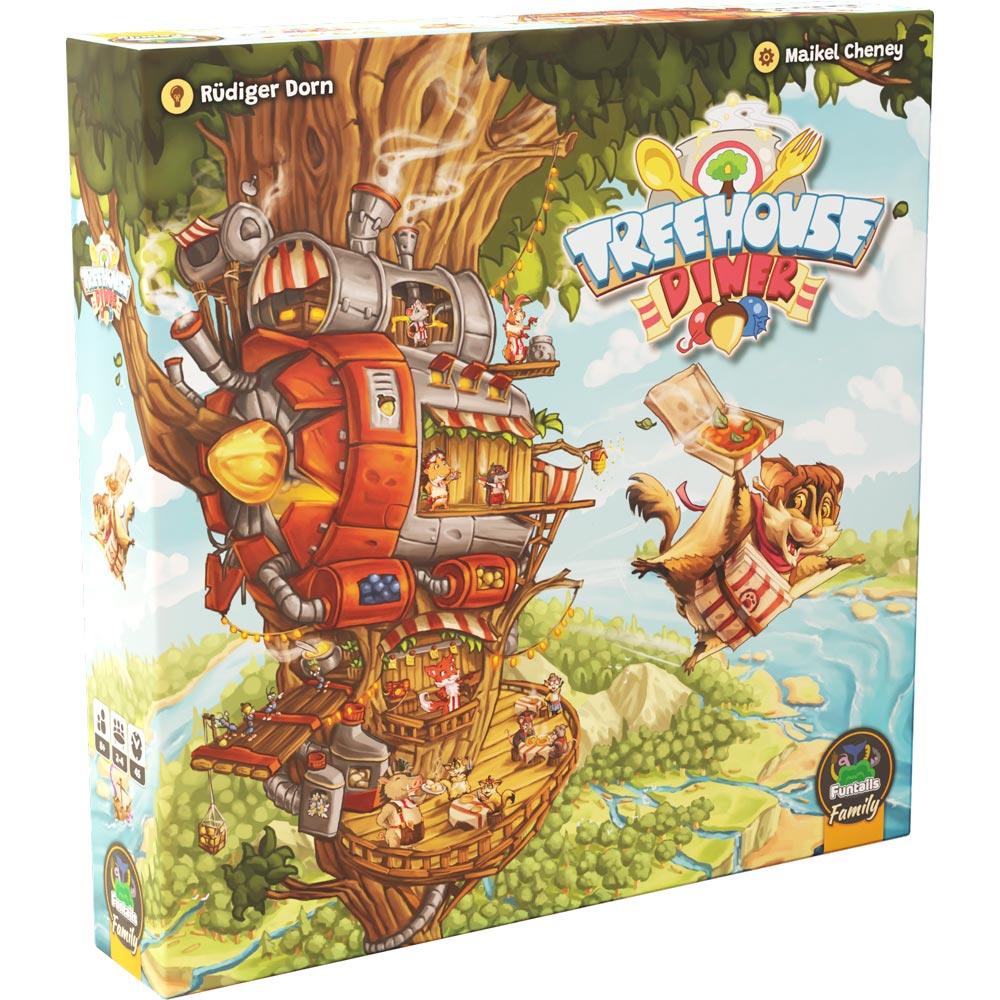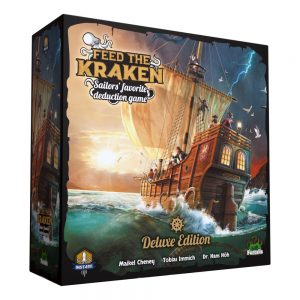“Treehouse Diner” is our first family game and was also Maikel’s first project as a game editor. You probably know him as co-author of “Feed the Kraken” or as captain on the game’s character cards. The redesign of Rüdiger Dorn’s “Da Luigi” was Maikel’s first step away from web developer to a full time job in the board game world. By now you can see and play the result. But how did “Da Luigi” become “Treehouse Diner”?

From the ancient times of Funtails
Shortly after the big bang of the company, Rüdiger Dorn and Steffen must have gotten together to brainstorm about the future games of this publisher. At least that’s how I imagine it. The approach underlying “Treehouse Diner” can be thought of as similar to the idea for “Glen More II” – “Da Luigi II Chronicles” is just a really terrible name for a family game.
Unfortunately, there was a printing mistake in the original game, which also introduced some rules inaccuracies. “Annoying” is still a very mild expression there. In addition, Rüdiger Dorn had worked out and collected even more adaptations.
Maikel and his way to the “Treehouse Diner”
“If I can play a game with my parents, Christmas isn’t so boring.” – perfect conditions for Maikel’s first project at Funtails! For the first two months of editorial work, Maikel spent most of his time playing and collecting ideas and suggestions for improvement. He built modules, tried them out and discarded them again to implement other ideas. This way he was able to narrow down the functions of the modules bit by bit.
And suddenly it was Christmas again! Of course, an editor does not work full time on a game. Besides, the daily business must be done – for example, Maikel also takes care of the Kickstarter. So, the more intensive development started only after the second endurance test during the Christmas visit to the family.
Then, finally, the time had come: the magical process of writing the rules had started! Probably it only seems “magical” from the outside. For Maikel, this step of his work was the moment when he finally had to decide on a version of the game. Writing is a decision-making process, where you have to summarize and specify the previous work.

The daily life of a board game editor
“For the first time in my life, I got to spend time during the day working on a board game!” Maikel usually had to push his authoring work on Feed the Kraken into the evenings or weekends. Turning a hobby into a job is quite a change – but in the board game world we have experience with that.
With a player count of 2-4 people, “Treehouse Diner” has pleasant conditions for the playtest sessions. Maikel often jumped into the test rounds alone and simulated a second player. Just like in the old days in the children’s room – only a lot more professional!
One important rule of thumb for working on family games guided Maikel through his work: the question “Can I play with my grandma with this rule?” So, even if only indirectly, Maikel’s grandma had a big influence on “Treehouse Diner.” Besides this framing, it was of course always important to keep the essence of “Da Luigi.”

Follow Maikel into the depths of the rules work!
What are the exact differences between “DaLuigi” and “Treehouse Diner”? Maikel gives a brief overview of the revisions for the new edition:
- The kitchen board has been fundamentally preserved. Maikel reports an “aha” moment after several rounds of testing that resulted in this key element remaining.
- The market display and customers: The changed names already give away: there were some innovations here! The market display became a pantry piece by piece and the customers moved to the telephone tableau. At “Da Luigi”, the take-that moment was also much stronger, as orders were placed directly. Maikel’s grandma would not have had the heart to put a bad order in someone’s hand. Therefore, the mechanism was modified so that all players now choose an order from the telephone display one after the other. This way, no grandma at the table must feel guilty!
- More about the market display: As already mentioned, this element has been completely revised. In the original, there was a completely different breakdown of costs. The cost was the number of ingredients -1, so a single ingredient was free. Maikel was sure, “My grandma won’t check that!” So, the cost was adjusted to the number of ingredients. The problem: Maikel had triggered inflation. Countermeasures had to be initiated: There are now more ways to get random ingredients and the pantry shelf bonuses have been invented. When a row of ingredients is emptied, the player in question receives a bonus. In return, everyone else at the table has a wider choice of ingredients.
- the number of players has been rebalanced. “Treehouse Diner” contains modular game plans that can be assembled differently depending on the number of people at the table.
5. and of course you should not forget about the integrated mini expansions! You can find more details here on the german product page of the game.

Tinkering passions
At Funtails we often play the games that are still in development online. If you answer mail or watch videos on the side, the downtime is of course less noticeable. (Which I never do, of course!) That’s why Maikel makes prototypes as early as possible to test with his gaming group. At the physical game table, you can also look the others in the eye when you snatch an important ingredient from under their noses!

Lots of questions for you!
We have already been able to show the first pictures of “Comet”. In January we should have the first prototypes to show. What would you like to know about our new game? Would you rather have an insight into the development story, like in this article? Maybe it’s the illustrations or the rules of the prototype that captivate you?
Here is an exclusive picture from a very secret playtest round of one of our next games:




